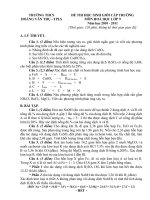trường thcs hoàng xuân hãn
Bạn đang xem bản rút gọn của tài liệu. Xem và tải ngay bản đầy đủ của tài liệu tại đây (38.37 KB, 2 trang )
<span class='text_page_counter'>(1)</span><div class='page_container' data-page=1>
<b>BRITISH COLUMBIA SECONDARY SCHOOL</b>
<b>MATHEMATICS CONTEST, 2007</b>
<b>Senior Preliminary</b>
<b>Wednesday March 7</b>
1. There were 20 people at a round table for dinner. At the end of the dinner, each person got up and
shook hands with everybody except the people who sat to their immediate right and left at dinner. The
total number of handshakes that took place is:
(A) 170 (B) 190 (C) 340 (D) 360 (E) 380
2. The number of prime numbers less than 100 that have digits that sum to 10 is
(A) 0 (B) 1 (C) 2 (D) 3 (E) 4
3. An isosceles right triangle has an area of 12.5 cm2<sub>. To the nearest centimetre, the perimeter of the</sub>
triangle is:
(A) 14 (B) 15 (C) 17 (D) 25 (E) 60
4. If <i>n</i> is a non-negative integer, then <i>n</i>factorial is <i>n</i>! = <i>n</i>×(n−1)×(n−2)× · · · ×2×1. So that
5!=5×4×3×2=120. The largest prime factor of 27!+28!+29! is
(A) 23 (B) 29 (C) 31 (D) 83 (E) 7
5. The number of real solutions of the equation<i>xx</i>2−5<i>x</i>+6<sub>=</sub><sub>1 is:</sub>
(A) 0 (B) 1 (C) 2 (D) 3 (E) 4
6. A regular polygon is a closed figure in the plane for which all of the sides are of equal length and the
interior angles, the angles between pairs of adjacent sides, are equal. The number of regular polygons
that have interior angles which are integers when expressed in degree measure is:
(A) 15 (B) 16 (C) 18 (D) 22 (E) 24
7. Of the following, the equations that have the same graph are:
<i>y</i>=<i>x</i>+4 (1)
<i>y</i>= <i>x</i>
2
−16
<i>x</i>−4 (2)
(x−4)y=<i>x</i>2−16 (3)
(A) (1) and (2) only (B) (1) and (3) only
(C) (2) and (3) only (D) (1), (2), and (3)
(E) None of these, since all have different
graphs
8. When simplified as much as possible the expression
3502
−3500+16
3500<sub>+</sub><sub>2</sub>
equals:
</div>
<span class='text_page_counter'>(2)</span><div class='page_container' data-page=2>
<b>BC Secondary School</b>
<b>Mathematics Contest</b> <b>Senior Preliminary, 2007</b> <b>Page 2</b>
9. Given that<i>z</i>2<sub>+</sub><i><sub>z</sub></i>
−3=5, the numerical value of<i>z</i>4+2<i>z</i>3−5<i>z</i>2−6<i>z</i>+5 is:
(A) 14 (B) 21 (C) 64 (D) 60<sub>−</sub>√33 (E) 60+√33
10. The shaded crescent shown is bounded by a semi-circle
and the arc of a second circle whose centre is on the first
circle. If the second circle has radius<i>r</i>, then the area of the
crescent is:
(A) <i>r</i>2 <sub>(B)</sub> 1
2<i>r</i>2 (C) <i>πr</i>2
(D) 1
2<i>πr</i>2 (E) 3
2<i>πr</i>2
11. Antonino and Ricardo go swimming together at the local pool. The ratio of Antonino’s swimming
speed to Ricardo’s is 3 : 2. Antonino and Ricardo start swimming lengths in the same lane, going in a
counterclockwise rotation, up one side of the lane and the back on the other side. Ricardo takes a one
quarter pool length head start, but, since Antonino swims faster, he catches up to and passes Ricardo.
If Antonino swims a total of 60 lengths of the pool, the number of times that Antonino catches up to
and passes Ricardo is:
(A) 9 (B) 10 (C) 11 (D) 12 (E) 13
12. A circle is inscribed in a right triangle with sides <i>a</i>, <i>b</i>, and<i>c</i>, where<i>c</i>
is the hypotenuse, as shown in the diagram. The radius of the circle is:
(A) 1<sub>2</sub>(a+<i>b</i>−<i>c)</i> (B) 12(a+<i>b</i>+<i>c)</i> (C)
√
<i>a</i>2<sub>+</sub><i><sub>b</sub></i>2<sub>+</sub><i><sub>c</sub></i>2
(D) 1<sub>2</sub>√<i>a</i>2<sub>+</sub><i><sub>b</sub></i>2<sub>+</sub><i><sub>c</sub></i>2 <sub>(E)</sub> <i><sub>a</sub></i><sub>+</sub><i><sub>b</sub></i><sub>−</sub><i><sub>c</sub></i>
<i>b</i>
</div>
<!--links-->









